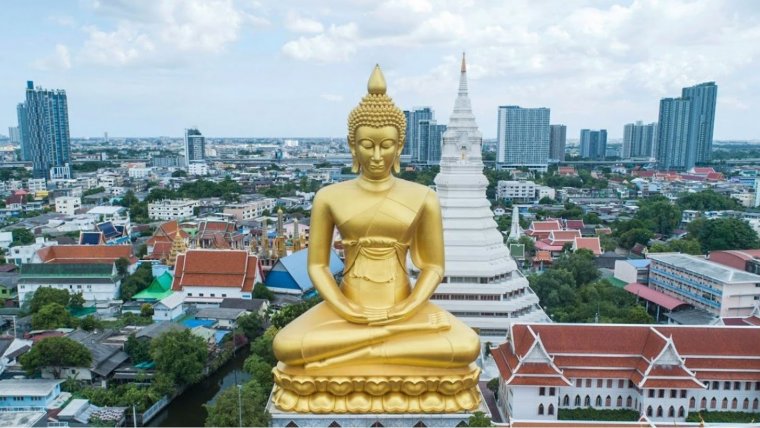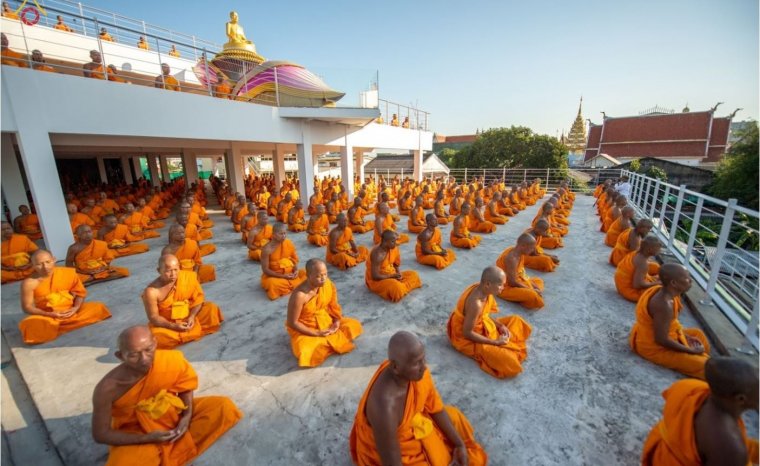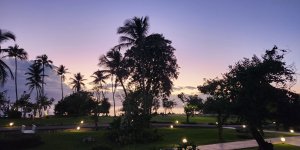| Published in Attractions / Places of Interest |
Wat Paknam Bhasicharoen, Thailand
Theravada Tradition, 17th century, 200–400 monks, 80–150 novices, 160–300 nuns.
Wat Paknam Bhasicharoen1 is a royal wat (temple or monastery) located in Phasi Charoen district, Bangkok, at the Chao Phraya River.

Wat Paknam Bhasicharoen Monastery and Phra Buddha Dhammakāya Thepmongkhon. Photo: Burutissara.
It is part of the Maha Nikaya fraternity and is the origin of the Dhammakaya tradition. It is a large and popular temple, supported by prosperous community members.
Location
History
Wat Paknam Bhasicharoen is a royal wat (temple or monastery) established in 1610, during the Ayutthaya period. Records indicate that King Suriyenthrathibodi (1703–1709) called the temple "Wat Prasat Suan Sawan"(literally: “temple of the heavenly garden palace”).
However, the name "Wat Paknam" and "Wat Paknam at the river Bang Luang" appear in historical documents of palace administration from 1780 onward. Paknam simply means 'lock in canal', which refers to the position of the temple.
The temple was renovated at least three times, during the periods of King Taksin, Rama III, and King Chulalongkorn (eighteenth–early twentieth century). However, during the period of King Rama VI (1881–1925), the temple had greatly deteriorated and had no abbot.
In 1916, senior monk Somdet Puean assigned Luang Pu Sodh Candasaro (1884–1959) as abbot. Luang Pu Sodh was known for his charisma and outspokenness.
The temple underwent a major change after he became the abbot, from a temple with only thirteen monks that was in disrepair, to a prosperous center of education and meditation practice with five hundred monks (the highest in Thailand at the time) and hundreds of nuns.
The temple became well known through Luang Pu Sodh's meditation method. Apart from teaching meditation, Luang Pu Sodh also built a school for Pali studies in 1950, which became a leading institute of the country.
Luang Pu Sodh has had a lasting impact on the temple, as his teachings and guided meditations are still taught at the temple today and his promotion of Buddhist scholarship has continued.
In the time of Luang Pu Sodh, the temple became popular with and well-supported by a prosperous community of high social class, mostly from the Bangkok area.
To compensate for the lack of local supporters, and at the same time dealing with the problem of local delinquent children causing trouble for the temple, Luang Pu Sodh set up a free primary school.
Luang Pu Sodh died in 1959, and his body has been kept in a coffin. The coffin is still a major point of attraction for the temple.
His remains have not been cremated, because of the large number of people still visiting the temple to pay their respects. Monastics at the temple still hold memorial ceremonies on a regular basis.
Luang Pu Sodh most important legacy is his teachings on Dhammakāya meditation2, which are still being passed on by Japanese Shingon Buddhists who practiced at the temple.
After Luang Pu Sodh death, Somdet Chuang Varapuñño was the monastery abbot from 1960 until 2012. He has also promoted ethics in Thai society, requesting television stations to remind viewers of the five Buddhist precepts3 during their broadcasts.
Features
The temple has a reputation for having made Dhammakaya meditation widely known in Thailand, through monks and lay teachers. Just as in the time of Luang Pu Sodh, there still is an evening meditation during which the practitioners listen to a tape of Luang Pu Sodh. There is also still meditation in shifts, as in the time when Luang Pu Sodh ran a “meditative knowledge factory.”

Meditating monks at Wat Paknam Monastery. Photo: ใจหยุด.
In 2014, Somdet Chuang started promoting the five precepts through a nationwide program The Villages Practicing the Five Precepts. In this program, held in cooperation with the National Office of Buddhism, villages are encouraged to agree on adhering to the five precepts unanimously.
Evaluations are held per monastic administrative region, and awards are given to exemplary villages that have eighty percent of villagers participating. Schools and colleges, local administration, Sangha, and private companies are all involved in promotion and practice.
The program has inspired several initiatives, for example, the promotion of five precepts among prisoners, and promotion of a vegetarian lifestyle.
In 2017, the National Office of Buddhism claimed that over 60% of Thailand's population was now involved in the program, amounting to more than 39 million people
Wat Paknam is a 32,000 square metres (7.9 acres) temple complex, with many buildings. Wat Paknam's oldest sections, still reveal its Ayutthaya origins and style. Following the old model, monks of the temple still go for alms in the surrounding lay community.
In 2004, Somdet Chuang took the initiative to start building an 80m high stupa at the temple, named "Maharatchamongkhon” (meaning “a blessed, great land”), with reference to the reign of the Royal Family, to which the stupa has been dedicated.
The stupa has five floors, including another 8-meter glass stupa, a room with relics, Buddha images and images of respected monks, including that of Luang Pu Sodh.
The structure also contains a meditation hall and a museum. Within the top of the stupa, Pali phrases have been carved into gold, praising mindfulness, moderation, and the upholding of the five precepts.
The halls have been decorated with paintings depicting Buddhist cosmology, based on the legend of Phra Malai and the ancient text Traibhumikatha.
The life of Luang Pu Sodh and that of Somdet Chuang are also depicted. The stupa was finished in 2012, costing a total of about 15 million US dollars.
In March 2017, Wat Paknam began building a Buddha image in honor of Luang Pu Sodh and the Thai Royal Family. Called "Phra Buddha Dhammakāya Thepmongkhon", the bronze image will be 69 meters tall, expected to be finished in 2021.
Visiting
The temple is open daily from 8:00AM to 6:00PM and has no admission fee. Visitors should wear non-revealing clothes.
Sources
https://en.wikipedia.org/wiki/Wat_Paknam_Bhasicharoen
https://www.dhammathai.org
https://retreat-infos.de
Footnotes
1. Or Wat Paknam Phasi Charoen, according to The Royal Thai General System of Transcription (RTGS), which is the official system for rendering Thai words in the Latin alphabet. It was published by the Royal Institute of Thailand
2. The Dhammakaya meditation method, also known as Sammā Arahaṃ meditation, is popular in Southeast Asia, and has been described as a revival of samatha (tranquility). The Dhammakaya tradition believes the method to be the same as the original method the Buddha used to attain enlightenment, which was lost and then rediscovered by Luang Pu Sodh in the 1910s.
3. The Five precepts (Sanskrit: pañcaśīla; Pali: pañcasīla) or five rules of training (Sanskrit: pañcaśikṣapada; Pali: pañcasikkhapada) is the most important system of morality for Buddhist lay people.
They constitute the basic code of ethics to be respected by lay followers of Buddhism. The precepts are commitments to abstain from killing living beings, stealing, sexual misconduct, lying and intoxication.
Within the Buddhist doctrine, they are meant to develop mind and character to make progress on the path to enlightenment. They are sometimes referred to as the Śrāvakayāna precepts in the Mahāyāna tradition, contrasting them with the bodhisattva precepts.
YOU MAY ALSO LIKE






 If you own or manage a travel-related business such as a hotel, a bed-and-breakfast, a restaurant, a pub or a cafeteria, you can create a web page for your business for free on Titi Tudorancea Travel Info. » |